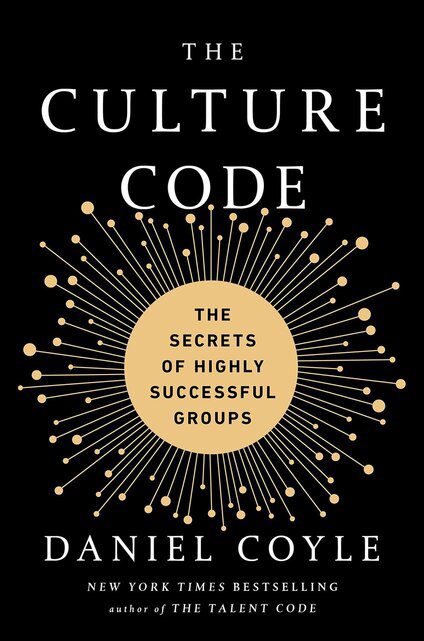“Culture is a set of living relationships working toward a shared goal. It’s not something you are. It’s something you do.”
Print | Kindle(eBooks) | Audiobooks
New York Times bestselling author of The Talent Code, Daniel Coyle, writes about highly successful groups’ secrets. In the Culture Code, Daniel chronicles what makes the world’s most successful organizations tick. He profiles great executives and teams in organizations such as Google, Disney, the U.S. Navy’s SEAL Team Six, IDEO, San Antonio Spurs, etc. According to Coyle, cultures are created by a specific set of skills. These skills tap into the power of our social brains to create interactions.
The Premise of the culture code is that group chemistry and building a successful team does not happen by accident; it results from strategies that enhance collaboration and trust-building, leading to positive change. Combining leading-edge science, on-the-ground insights from world-class leaders, and practical ideas for action, The Culture Code offers a roadmap for creating an environment where innovation flourishes, problems get solved, and expectations are exceeded.
Here are my favourite take-aways from reading, The Culture Code by Daniel Coyle.:
A strong culture increases net income 756 percent over eleven years, according to a Harvard study of more than two hundred companies.
Cultures are created by a specific set of skills. These skills, which tap into the power of our social brains to create interactions:
- Skill 1—Build Safety—explores how signals of connection generate bonds of belonging and identity
- Skill 2—Share Vulnerability—explains how habits of mutual risk drive trusting cooperation.
- Skill 3—Establish Purpose—tells how narratives create shared goals and values.
The three skills work together from the bottom up, first building group connection and then channeling it into action.
“Culture is a set of living relationships working toward a shared goal. It’s not something you are. It’s something you do.”
Skill 1: Build Safety
Chemistry
When you encounter a group with good chemistry, you know it instantly. It’s a paradoxical, powerful sensation, a combination of excitement and deep comfort that sparks mysteriously with certain special groups and not with others. There’s no way to predict it or control it.
Belonging cues
Belonging cues are behaviors that create safe connection in groups. They include, among others, proximity, eye contact, energy, mimicry, turn taking, attention, body language, vocal pitch, consistency of emphasis, and whether everyone talks to everyone else in the group.
Belonging cues possess three basic qualities:
1. Energy: They invest in the exchange that is occurring
2. Individualization: They treat the person as unique and valued
3. Future orientation: They signal the relationship will continue
Psychological Safety.
These cues add up to a message that can be described with a single phrase: You are safe here. They seek to notify our ever-vigilant brains that they can stop worrying about dangers and shift into connection mode.
In the 1990s, sociologists James Baron and Michael Hannan analyzed the founding cultures of nearly two hundred technology start-ups in Silicon Valley.
They found that most followed one of three basic models
– The star model, the professional model, and the commitment model.
The star model focused on finding and hiring the brightest people.
The professional model focused on building the group around specific skill sets.
The commitment model, on the other hand, focused on developing a group with shared values and strong emotional bonds. Of these, the commitment model consistently led to the highest rates of success.
One misconception about highly successful cultures is that they are happy, lighthearted places. This is mostly not the case. They are energized and engaged, but at their core their members are oriented less around achieving happiness than around solving hard problems together. This task involves many moments of high-candor feedback, uncomfortable truth-telling, when they confront the gap between where the group is, and where it ought to be.
“Overdo Thank-Yous: When you enter highly successful cultures, the number of thank-yous you hear seems slightly over the top. ”
Make Sure Everyone Has a Voice: Toyota Andon
Ensuring that everyone has a voice is easy to talk about but hard to accomplish. This is why many successful groups use simple mechanisms that encourage, spotlight, and value full-group contribution.
Avoid Giving Sandwich Feedback:
In many organizations, leaders tend to deliver feedback using the traditional sandwich method: You talk about a positive, then address an area that needs improvement, then finish with a positive. This makes sense in theory, but in practice it often leads to confusion, as people tend to focus either entirely on the positive or entirely on the negative
Embrace Fun:
This obvious one is still worth mentioning, because laughter is not just laughter; it’s the most fundamental sign of safety and connection.
Skill 2: Share Vulnerability
Normally, we think about trust and vulnerability the way we think about standing on solid ground and leaping into the unknown: first we build trust, then we leap. But science is showing us that we’ve got it backward. Vulnerability doesn’t come after trust—it precedes it. Leaping into the unknown, when done alongside others, causes the solid ground of trust to materialize beneath our feet.
Vulnerability doesn’t come after trust—it precedes it. Leaping into the unknown, when done alongside others, causes the solid ground of trust to materialize beneath our feet.
Building habits of group vulnerability is like building a muscle. It takes time, repetition, and the willingness to feel pain in order to achieve gains. And as with building muscle, the first key is to approach the process with a plan.
Make Sure the Leader Is Vulnerable First and Often
Laszlo Bock, former head of People Analytics at Google, recommends that leaders ask their people three questions:
• What is one thing that I currently do that you’d like me to continue to do?
• What is one thing that I don’t currently do frequently enough that you think I should do more often?
• What can I do to make you more effective?
Overcommunicate Expectations
The successful groups do not presume that cooperation would happen on its own. Instead, they were explicit and persistent about sending big, clear signals that established those expectations, modeled cooperation, and aligned language and roles to maximize helping behavior.
Deliver the Negative Stuff in Person
If you have negative news or feedback to give someone—even as small as a rejected item on an expense report—you are obligated to deliver that news face-to-face.
This rule is not easy to follow (it’s far more comfortable for both the sender and receiver to communicate electronically), but it works because it deals with tension in an up-front, honest way that avoids misunderstandings and creates shared clarity and connection.
When Forming New Groups, Focus on Two Critical Moments
Jeff Polzer, the Harvard Business School professor who studies organizational behavior, traces any group’s cooperation norms to two critical moments that happen early in a group’s life. They are:
1. The first vulnerability
2. The first disagreement
Listen Like a Trampoline
Good listening is about more than nodding attentively; it’s about adding insight and creating moments of mutual discovery. Jack Zenger and Joseph Folkman, who run a leadership consultancy, analyzed 3,492 participants in a manager development program and found that the most effective listeners do four things:
1. They interact in ways that make the other person feel safe and supported
2. They take a helping, cooperative stance
3. They occasionally ask questions that gently and constructively challenge old assumptions
4. They make occasional suggestions to open up alternative paths
As Zenger and Folkman put it, the most effective listeners behave like trampolines. They aren’t passive sponges. They are active responders, absorbing what the other person gives, supporting them, and adding energy to help the conversation gain velocity and altitude.
In Conversation, Resist the Temptation to Reflexively Add Value
The most important part of creating vulnerability often resides not in what you say but in what you do not say. This means having the willpower to forgo easy opportunities to offer solutions and make suggestions. Skilled listeners do not interrupt with phrases like Hey, here’s an idea or Let me tell you what worked for me in a similar situation because they understand that it’s not about them. They use a repertoire of gestures and phrases that keep the other person talking.
BrainTrusts
BrainTrusts, the project-based method pioneered by Pixar, involve assembling a team of experienced leaders who have no formal authority over the project and letting them critique its strengths and weaknesses in a frank and open manner. A key rule of BrainTrusts is that the team is not allowed to suggest solutions, only to highlight problems.
Red Teaming
Red Teaming is a military-derived method for testing strategies; you create a “red team” to come up with ideas to disrupt or defeat your proposed plan. The key is to select a red team that is not wedded to the existing plan in any way, and to give them freedom to think in new ways that the planners might not have anticipated.
Aim for Candor; Avoid Brutal Honesty
Giving honest feedback is tricky, because it can easily result in people feeling hurt or demoralized.
Embrace the Discomfort
One of the most difficult things about creating habits of vulnerability is that it requires a group to endure two discomforts: emotional pain and a sense of inefficiency.
Use Flash Mentoring:
It is exactly like traditional mentoring—you pick someone you want to learn from and shadow them—except that instead of months or years, it lasts a few hours. Those brief interactions help break down barriers inside a group, build relationships, and facilitate the awareness that fuels helping behavior.
Skill 3; Establish Purpose
High-purpose environments are filled with small, vivid signals designed to create a link between the present moment and a future ideal.
The difference with successful cultures seems to be that they use the crisis to crystallize their purpose. When leaders of those groups reflect on those failures now, they express gratitude (and sometimes even nostalgic desire) for those moments, as painful as they were, because they were the crucible that helped the group discover what it could be.
Name and Rank Your Priorities:
In order to move toward a target, you must first have a target. Listing your priorities, which means wrestling with the choices that define your identity, is the first step.
Figure Out Where Your Group Aims for Proficiency and Where It Aims for Creativity
Skills of proficiency are about doing a task the same way, every single time. They are about delivering machine-like reliability, and they tend to apply in domains in which the goal behaviors are clearly defined, such as service.
Creative skills, on the other hand, are about empowering a group to do the hard work of building something that has never existed before.
Embrace the Use of Catchphrases
When you look at successful groups, a lot of their internal language features catchphrases that often sound obvious, rahrah, or corny. Many of us instinctively dismiss them as cultish jargon. But this is a mistake. Their occasionally cheesy obviousness is not a bug—it’s a feature. Their clarity, grating to the outsider’s ear, is precisely what helps them function.
Measure What Really Matters
The main challenge to building a clear sense of purpose is that the world is cluttered with noise, distractions, and endless alternative purposes. One solution is to create simple universal measures that place focus on what matters.
Use Artifacts
If you traveled from Mars to Earth to visit successful cultures, it would not take you long to figure out what they were about. Their environments are richly embedded with artifacts that embody their purpose and identity.
Focus on Bar-Setting Behaviors
One challenge of building purpose is to translate abstract ideas (values, mission) into concrete terms. One way successful groups do this is by spotlighting a single task and using it to define their identity and set the bar for their expectations.
All the Best in your quest to get Better. Don’t Settle: Live with Passion.



1 Comment
Pingback: 100 Books Reading Challenge 2021 – Lanre Dahunsi